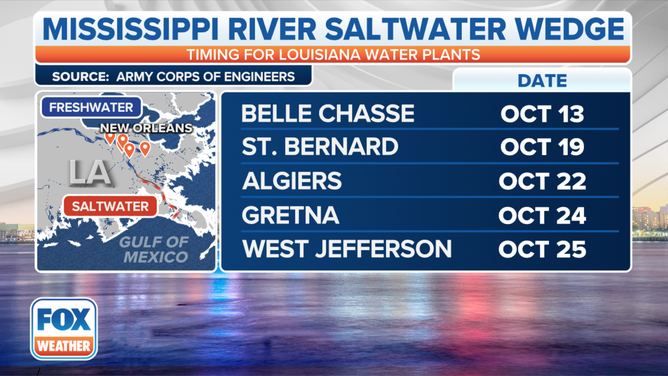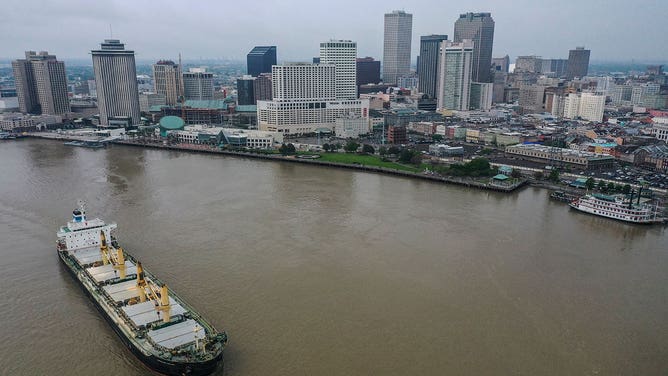Salt water continues advancing on Mississippi River as Orleans Parish explores drinking water options
Officials with the Sewerage & Water Board of New Orleans hope the pipeline could be a permanent solution for the saltwater intrusion, which has happened two years in a row because of extreme drought and low water flow in the Mississippi River.
U.S. Army Corps of Engineers working to buy time against salt water moving up Mississippi River
Ricky Boyett, with the U.S. Army Corps of Engineers, explains how raising a sill, or underwater levee, will buy time to hold off salt water intruding on the lower Mississippi River. Salt water from the Gulf of Mexico is threatening drinking water in Louisiana because of the low water levels in the river.
NEW ORLEANS – Louisiana parishes are bracing for impacts to drinking water that are set to arrive by mid-to-late October near New Orleans as salt water from the Gulf of Mexico continues intruding further up the Mississippi River.
Drought and low water levels in the lower Mississippi River have allowed salt water from the Gulf of Mexico to win the battle and push farther up the river, impacting local water treatment centers.
On Wednesday, President Joe Biden approved an emergency declaration requested by Louisiana Gov. John Bel Edwards for the four parishes threatened by the advancing salt water.
Current drinking water advisories in Louisiana
The Environmental Protection Agency's maximum containment level for chloride is 250 milligrams per liter. As of Thursday, Plaquemines Parish remains the only parish where the drinking water has exceeded those levels.
Sodium levels have also exceeded higher levels than usual. While the EPA does not classify sodium as a contaminant, individuals on a low-sodium diet for health reasons should pay special attention to sodium levels in their drinking water.
The saltwater intrusion has impacted two water facilities: Boothville (Port Sulphur) and Pointe A la Hache. Bottled water distribution sites are active in Plaquemines Parish, and the Port Sulphur Water Treatment Plant, which had been down for two years since Hurricane Ida, is now back up and running amid the water emergency.
The seawater will eventually impact drinking water in New Orleans and surrounding parishes. Based on the timeline provided by the U.S. Army Corps of Engineers New Orleans District, Orleans Parish could begin seeing salt water affect drinking water by Oct. 22.
Orleans Parish considers water pipeline to bypass salt water
Orleans Parish leaders are exploring additional options for freshwater, including a pipeline that would bring water from upriver to New Orleans, bypassing the salt water wedge.

When the salt water is expected to arrive across Louisiana.
(FOX Weather)
Officials with the Sewerage & Water Board of New Orleans (SWBNO) told the New Orleans City Council Public Works Committee on Wednesday that the pipeline could be a permanent solution for the saltwater intrusion, which has happened two years in a row because of extreme drought upriver and low water flow in the Mississippi River.
"SWBNO has also identified an area near Kenner (around river mile 115) where we could potentially construct a new intake upriver of the saltwater wedge," the Board said in a statement. "The Army Corps advised us of a large hydrogeologic feature in this area of the river that the Corps believes will act as a natural barrier, preventing the saltwater wedge from creeping further upriver."
NEW ORLEANS FRESHWATER SUPPLY THREATENED BY SALT WATER CREEPING INTO MISSISSIPPI RIVER
The SWBNO has requested federal funding to start the construction of this pipeline and intake.
Orleans Parish officials are also considering bringing fresh water via barge and mixing it with the overall salty river to reduce the salt content, a preventative measure already happening in Plaquemines Parish.
Two water plants serve the New Orleans area. The Carrolton Water Treatment Plant on the Eastbank of New Orleans treats about 150 million gallons of water daily, and the Algiers Water Treatment Plant serves the Westbank with about 12.5 million gallons of water daily.
U.S. Army Corps of Engineers continues work to hold off Gulf of Mexico
The U.S. Army Corps of Engineers New Orleans District began work on Monday to raise the underwater levee, or sill, by an additional 25 feet. The sill is designed to delay the salt water from the Gulf of Mexico from moving up the river.
Salt water overtook the original sill constructed in July on Sept. 20. Construction of the augmented sill is expected to take several weeks to complete.

An aerial view of New Orleans can be seen from a drone above the Mississippi River on April 1, 2023, in New Orleans, Louisiana.
(Ricky Carioti/The Washington Post / FOX Weather)
U.S. Army Corps of Engineers New Orleans District Public Affairs Chief Ricky Boyett told FOX Weather that the Mississippi River needs about 300,000 cubic feet per second to push the salt water back into the Gulf. Currently, the flow is about half that.
Rain in the Midwest is the only long-term solution for the ongoing drought causing the low levels in the Mississippi River. In the near future, significant rain isn't forecast to help increase the flow needed to hold off the seawater.
